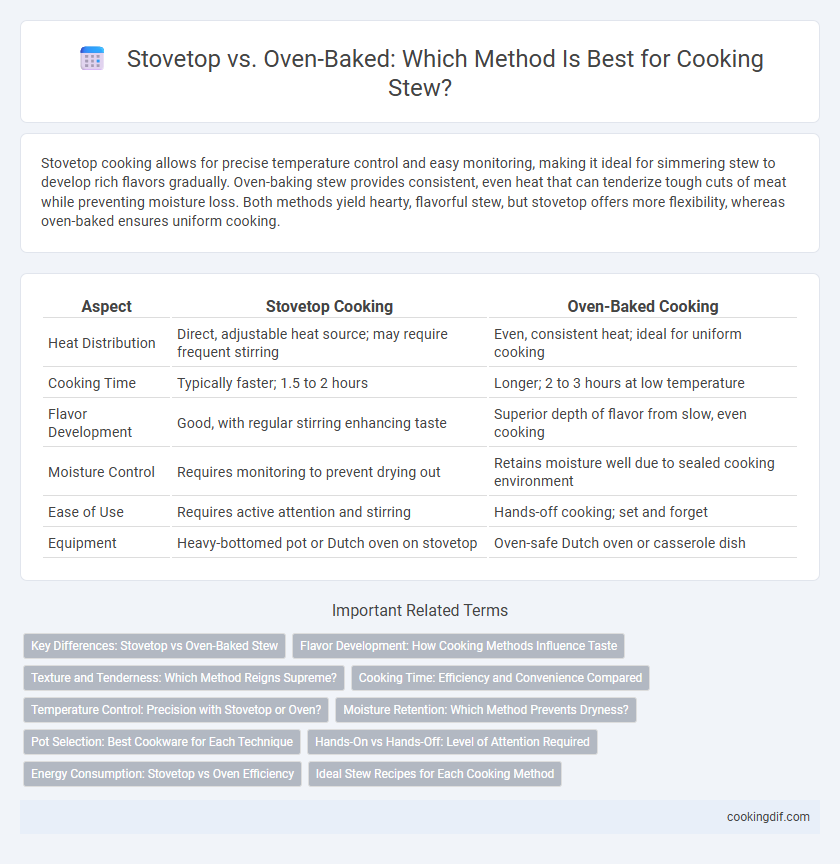Stovetop cooking allows for precise temperature control and easy monitoring, making it ideal for simmering stew to develop rich flavors gradually. Oven-baking stew provides consistent, even heat that can tenderize tough cuts of meat while preventing moisture loss. Both methods yield hearty, flavorful stew, but stovetop offers more flexibility, whereas oven-baked ensures uniform cooking.
Table of Comparison
| Aspect | Stovetop Cooking | Oven-Baked Cooking |
|---|---|---|
| Heat Distribution | Direct, adjustable heat source; may require frequent stirring | Even, consistent heat; ideal for uniform cooking |
| Cooking Time | Typically faster; 1.5 to 2 hours | Longer; 2 to 3 hours at low temperature |
| Flavor Development | Good, with regular stirring enhancing taste | Superior depth of flavor from slow, even cooking |
| Moisture Control | Requires monitoring to prevent drying out | Retains moisture well due to sealed cooking environment |
| Ease of Use | Requires active attention and stirring | Hands-off cooking; set and forget |
| Equipment | Heavy-bottomed pot or Dutch oven on stovetop | Oven-safe Dutch oven or casserole dish |
Key Differences: Stovetop vs Oven-Baked Stew
Stovetop stew cooking offers precise temperature control and faster adjustments, allowing quicker reductions and flavor development through active stirring. Oven-baked stew provides even, consistent heat distribution, resulting in uniform tenderization of meats and deeper melding of flavors over longer cooking times. The choice impacts texture and taste intensity, with stovetop methods favoring quicker, more robust results and oven-baking promoting slow, thorough flavor integration.
Flavor Development: How Cooking Methods Influence Taste
Stovetop cooking allows for better control over simmering temperature, promoting gradual flavor melding and a richer, more complex taste in stew. Oven-baking stews ensures consistent, even heat, enhancing caramelization and deepening the stew's savory notes. Both methods influence the Maillard reaction differently, with stovetop offering more flexibility and oven-baking providing steady, intense flavor development.
Texture and Tenderness: Which Method Reigns Supreme?
Stovetop cooking allows for precise temperature control, resulting in evenly tender meat and a thick, hearty stew texture due to slow simmering. Oven-baked stew offers consistent, gentle heat that enhances collagen breakdown, producing exceptionally tender meat and rich, concentrated flavors. For superior texture and tenderness, oven-baked stews often reign supreme by creating a deeper meld of flavors and melt-in-your-mouth meat.
Cooking Time: Efficiency and Convenience Compared
Stovetop cooking typically allows stews to simmer steadily at controlled temperatures, often reducing cooking time to 1.5-2 hours for tender results, which enhances efficiency for busy meals. Oven-baked stews benefit from even heat distribution, but usually require longer durations, around 2.5-3 hours, making them less convenient when time is limited. Choosing between methods depends on balancing the stovetop's quicker cooking time and ease of monitoring against the oven's more hands-off approach and consistent heat.
Temperature Control: Precision with Stovetop or Oven?
Stovetop cooking offers precise temperature control by allowing immediate adjustments to heat intensity, crucial for maintaining consistent simmering in stew. Oven-baking provides even, steady heat distribution, reducing the risk of hot spots and ensuring uniform cooking throughout the stew. Choosing between the two depends on the need for dynamic temperature changes or consistent, gentle heat for optimal stew texture and flavor development.
Moisture Retention: Which Method Prevents Dryness?
Stovetop cooking excels in moisture retention by allowing simmering at controlled temperatures, preventing the stew from drying out through gentle, consistent heat and frequent moisture monitoring. Oven-baking, while often resulting in rich, evenly cooked flavors, can lead to moisture loss if the lid is not tightly sealed, causing the stew to dry out over long cooking times. Choosing stovetop simmering is ideal for maintaining optimal moisture levels, especially for delicate stews requiring tender, juicy ingredients.
Pot Selection: Best Cookware for Each Technique
Choosing the right pot significantly influences stew quality, with stovetop methods benefiting from heavy-bottomed, enameled cast iron or stainless steel pots that provide even heat distribution and prevent scorching. Oven-baked stews excel in Dutch ovens or ceramic pots that ensure consistent indirect heat and moisture retention for tender, flavorful results. Selecting cookware designed to maintain steady temperatures enhances the cooking process by optimizing heat control and maximizing flavor development in both techniques.
Hands-On vs Hands-Off: Level of Attention Required
Stovetop stew demands continuous monitoring and stirring to prevent scorching and ensure even cooking, requiring a hands-on approach. Oven-baked stew benefits from consistent, indirect heat, allowing for hands-off cooking that frees time for other tasks. Choosing between stovetop and oven methods influences the cook's level of attention and involvement throughout the preparation process.
Energy Consumption: Stovetop vs Oven Efficiency
Stovetop cooking typically consumes less energy for stews due to its direct heat application and shorter cooking times, whereas oven-baked stews require prolonged heating that increases energy use. Electric ovens generally have lower energy efficiency compared to stovetop burners, often leading to higher utility costs when slow-cooking recipes like stew. Optimizing stovetop simmering temperatures can further reduce energy consumption without compromising flavor or texture.
Ideal Stew Recipes for Each Cooking Method
Stovetop stew recipes excel with ingredients that benefit from slow, consistent simmering, such as tougher cuts of beef, root vegetables, and hearty beans, ensuring rich, well-developed flavors and tender textures. Oven-baked stews are ideal for recipes requiring even, radiant heat that envelopes the pot, perfect for layered flavors in dishes like classic beef bourguignon or lamb stew. Both methods benefit from using low, steady heat, but oven cooking provides a more uniform temperature, reducing the need for frequent stirring and promoting deeper flavor integration.
Stovetop vs oven-baked for cooking stew Infographic

 cookingdif.com
cookingdif.com